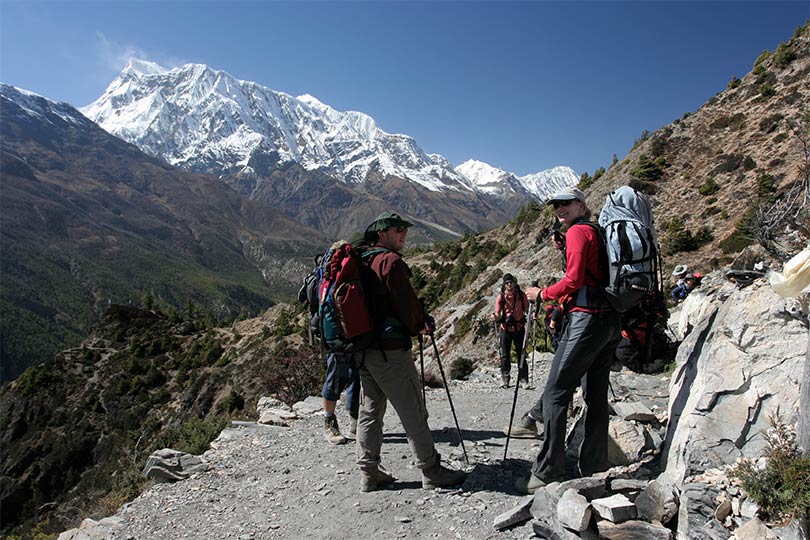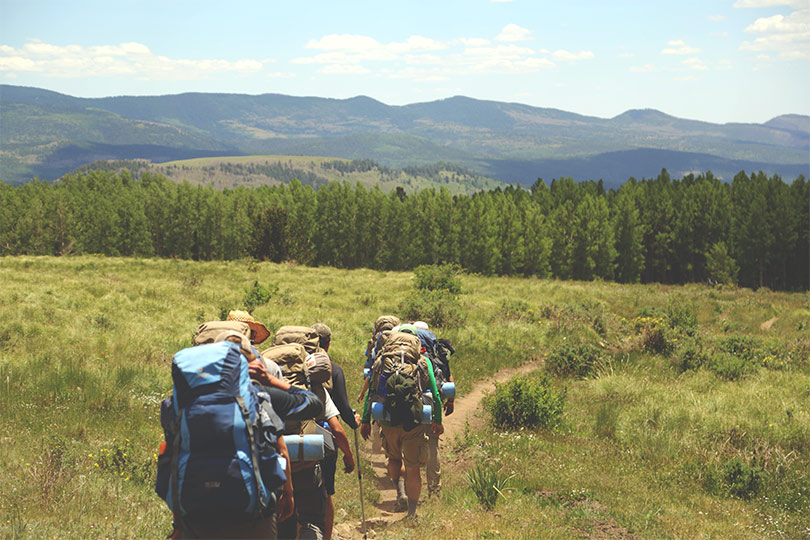Packing list for hiking is an essential component of a trip, especially if you are a newbie. If you have been bitten by a travel bug and wish to hike soon, it is always advisable to make a checklist of essential items for a successful trip. Backpacking trips to some remote locations will help unwind the constant pressure of always being available for everyone. It will also find you courage to handle responsibilities to test your limits! Hiking in the wilderness has always rejuvenated the lost energy of monotonously hardworking souls, indeed.

Go solo or plan with your travel mates. It is perhaps the best way to celebrate and enjoy life. As people say, nature heals and nature brings the best of you even when you aren’t ready for it. To start it off, the goal isn’t just reaching the destination with swollen legs and an empty stomach. To make it worse, if you are a rookie traveler, you might end up with a 33-lb (15 kg) backpack for an overnight hike and without a plan.
Whether it is a day hike or a multi-day hike, know about your pace, your destination’s connectivity, the weather, and your backup plan if things don’t go as smoothly as anticipated.
Out in the wild, there is no substitution to proper preparation! Knowing about yourself and the destination is the key to your success. The more you are prepared, the more you are confident and you will enjoy your journey. So, what do I bring on a hike? Get going and know about what to pack for hiking, if you are planning one soon. You can find the perfect packing list for Everest base camp trek, if that has been on your bucket list for quite some time now!
Packing list for a successful hiking trip
Wondering where to start? Avoid cramped legs and being lost in the middle of nowhere without a standby plan. As referenced by frequent backpackers and professional mountain climbers, this packing list for hiking will certainly help you to hike like a pro. The essentials you should bring are:

1. Right Hiking Boots
Choosing correct hiking boots is the primary diligence to ensure a comfortable and safe hiking experience. Make sure, you have the correct size that offers enough room to wiggle your toes. Oh yeah! Don’t forget to wear and pack proper socks too.
Know your pace and settle into your natural rhythm, since enjoyable hiking depends on stamina, not speed.
2. Map and compass/GPS
As old-fashioned as it may seem, you must carry a map and a compass or satellite GPS all the time. Yes, offline maps and various apps can be great resources, but you need to be prepared for chances of the lack of reception or a dead battery, especially if you have thought of trekking in Nepal in the future.
3. Food and Water
When it comes to hiking, staying well-hydrated and eating well are equally substantial. Travel with foods that are high on energy, compact and easy to cook. If you’re planning for a multi-day hike, it is advisable to carry a portable water filter or a purifying solution to treat water from outdoor sources.
4. Rain gear and quick-drying layers
Weather is as unpredictable as a mood swing. Agree? We can never be sure of the weather forecasts, especially in the mountains. Hence, it is better to hike with essential gears where a versatile, lightweight and breathable rain jacket is the savior.
5. Safety elements
As an assurance to your safety, don’t forget to carry a small flashlight, a whistle and a lighter. These are for the extreme situations you might find yourself in. In case of emergency, be absolutely alert and if you’re going to start a fire, you must be aware of both the rightfulness of doing so while considering the environmental conditions.
6. First aid kit
Accidents happen when we least expect. And when it does, having a basic first aid kit is a requisite. The Red Cross has a list of easy-to-find items to stock up on your essential kits. Add on your specific needs, whether that’s a prescribed medication, Odomus, Pepto Bismol, or just some extra Band-Aids.
7. Sun protection
Sunscreens are underrated! Every hiker or a mountain climber who’s been victim to dark spots and tan lines will advise you to apply enough and suitable sunscreen before you begin your hike with a hat and sunglasses, even when it’s cloudy. It’s a must!
8. Shelter
If you are going for a multi-day hike, make sure that you are well informed about lodging facilities and have a camp or lodge reservation before the trip. Just in case, carry a space blanket for emergency.
9. A trash bag
Hiking to remote places is rewarding, personally and communally as well. You are contributing to the economic and social life of the people living in that area. It is a win-win state of play for all. So, make sure you carry your trash off the trail with you. Even better, you can contribute to collect the trashes and be amazed at how much you can help for a tidier trail.
What should I wear on a hike?
Confused on what to wear on the trail? Firstly, decide how long you are going to hike. Is it a 3 to 4 hours hike or more than 6 hours? Make sure your clothes are comfortable and well suited for the journey. Next, consider doing little research on the ecosystem of the trail. Is it for a higher altitude region or at sea level? Is it dry or humid? Then, check the weather forecast, although you can’t fully depend, but you sure can anticipate.

1. Choosing appropriate layers
You can go with a base layer of a comfortable T-shirt or a tank top, mid layer with a light weight jacket, fleece or a long-sleeve t-shirt and a top breathable wind/rain shell. If you are planning to hike to a colder destination, upgrade your layers accordingly as choosing layers highly depend on the weather of the destination.
2. Choosing appropriate fabrics
You need to completely avoid buying cotton if you are planning for a hike or trek. Owing to its nature, you will feel sweaty in warm weather and get chills in the cold as cotton absorbs and retains water.
Then, what type of fabric should I choose? You can go for synthetics as it is commonly available, allows airflows and movement. Or you can opt for eco-friendly merino wool instead. Rest assured, it isn’t scratchy! It is fully natural, soft against your skin, and decreases odor. Also, fleece made from recycled materials is a great option.
Well, if you have Africa on your list of to-do things, it is equally important to know beforehand about all essentials, including equipment and gears. Kilimanjaro Climb has always allured trekkers from around the globe, and if that’s on your bucket-list too, then a complete packing list for Tanzania travel would be very handy. Unless you wish to visit the country for other reasons apart from adventure & safari holidays, it is quite imperative that you know all about what to carry while on a backpacking holiday.

Tips for packing your hiking gear
You definitely don’t wish to struggle with a broken zip and heavy weight in the middle of nowhere. So, just like your shoes and clothes, you need to carry a backpack with a perfect fit. While packing your bag, make sure you can handle the weight and access your necessities without any difficulties.
Quick tips:
- For a comfortable and balanced hiking experience, keep the heavier items in your backpack, in the center and close to your back while the lighter ones can fill in the space around the heavier items.
- Don’t over-pack and also don’t underprepare when it comes to packing. You need to find the perfect balance between them. It only comes when you are well informed and well prepared for the trip.
- Keep the things like water, snacks, phone, sunscreen and extra layers where you can easily reach, rather than submerged at the bottom of the bag.

A leading adventure & tour operator in the Himalayas since 1992, Himalayan Glacier Adventure & Travel Company® is the #1 guiding adventure travel company on Mount Everest Base Camp and beyond with 98% success rate. Each of our holidays is truly a tailor-made package which we design for all ages, groups, families & solo travelers.






